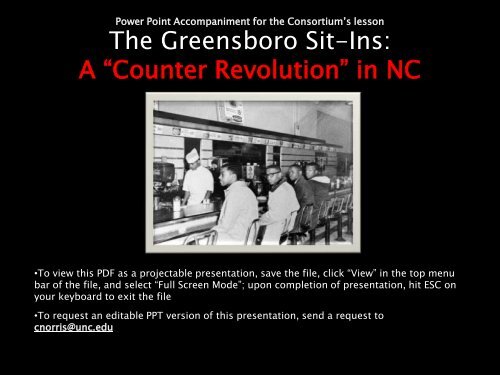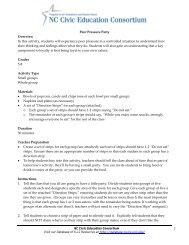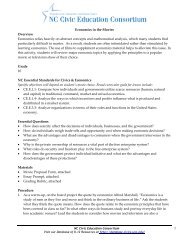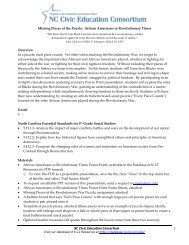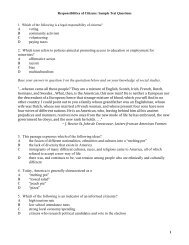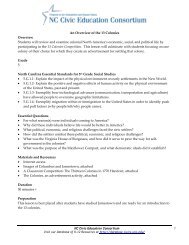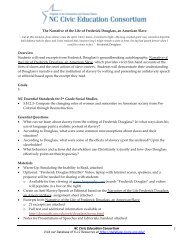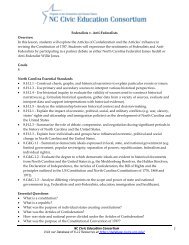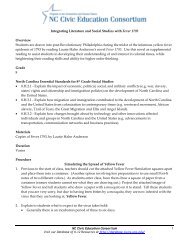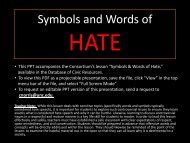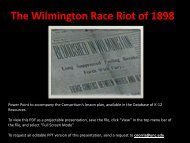The Greensboro Sit-Ins
The Greensboro Sit-Ins
The Greensboro Sit-Ins
You also want an ePaper? Increase the reach of your titles
YUMPU automatically turns print PDFs into web optimized ePapers that Google loves.
Power Point Accompaniment for the Consortium’s lesson<br />
<strong>The</strong> <strong>Greensboro</strong> <strong>Sit</strong>-<strong>Ins</strong>:<br />
A “Counter Revolution” in NC<br />
•To view this PDF as a projectable presentation, save the file, click “View” in the top menu<br />
bar of the file, and select “Full Screen Mode”; upon completion of presentation, hit ESC on<br />
your keyboard to exit the file<br />
•To request an editable PPT version of this presentation, send a request to<br />
cnorris@unc.edu
SEGREGATION
What “double standard” do you think this poster is referring to<br />
People demonstrating outside the Kress department store in <strong>Greensboro</strong>, NC in 1960.
A New Form of Protest: <strong>Sit</strong>-<strong>Ins</strong><br />
• As a means of<br />
protesting<br />
segregated lunch<br />
counters and<br />
stores, African<br />
Americans and<br />
white allies began<br />
to organize “sitins,”<br />
a form of<br />
peaceful protest<br />
in which<br />
participants would<br />
take a seat meant<br />
for “whites only”<br />
and wait for<br />
service.
2<br />
6<br />
4<br />
1<br />
3<br />
5<br />
7
“<strong>The</strong> <strong>Greensboro</strong> Four”<br />
• Why do you think the simple act of four friends sitting at a lunch<br />
counter was considered “legendary”<br />
• What were Franklin, Ezell, Joseph, and David risking by sitting at the<br />
“white only” counter<br />
• Why do you think the students refused to respond to the threats and<br />
harassment they experienced with violence<br />
• Why do you think the sit-in movement spread to so many other<br />
cities and states<br />
• How would you characterize the four college students who started<br />
this movement, as well as all the other high school and college<br />
students who participated<br />
• Why is it important to stand up for what you believe in<br />
• What are other ways you can make a difference, regardless of your<br />
age
“<strong>The</strong> <strong>Greensboro</strong> Four”
<strong>The</strong> <strong>Greensboro</strong> <strong>Sit</strong>-In: Feb. 1, 1960<br />
• On February 1st, 1960, four students from<br />
North Carolina A&T University walked into a<br />
Woolworth store in <strong>Greensboro</strong>.<br />
• <strong>The</strong>y made several purchases, then sat down<br />
at the “whites-only” lunch counter and<br />
ordered coffee.<br />
• <strong>The</strong>y were denied service, ignored and then<br />
asked to leave.<br />
• Police arrived on the scene, but without<br />
provocation, no arrest could be made.<br />
• <strong>The</strong>y remained seated at the counter until the<br />
store closed early at 5 p.m.<br />
• <strong>The</strong> four friends immediately returned to<br />
campus and recruited others for the cause.
<strong>The</strong> <strong>Greensboro</strong> <strong>Sit</strong>-In: Feb. 2, 1960<br />
• Twenty-five men (including the four freshmen) & four women<br />
returned to the F.W. Woolworth store on Feb. 2, 1960.<br />
• <strong>The</strong> students sat from 11 a.m. to 3 p.m. while white patrons<br />
heckled them. Undaunted, they sat with books and study<br />
materials.<br />
• AP news reporters & local TV news crews monitored the<br />
scene.<br />
• Police were again present, the students remained peaceful,<br />
and were again refused service.<br />
• Once the sit-ins hit the news, momentum picked up and<br />
students across the community embraced the movement. (By<br />
the next day, protests in High Point, NC occurred.)
<strong>The</strong> <strong>Greensboro</strong> <strong>Sit</strong>-In: Feb. 3-4, 1960<br />
• By opening time, there were students scrambling to get seats at<br />
Woolworth’s, but there was also a growing opposition group.<br />
• Whites continually taunted the demonstrators, who refused to respond to<br />
incitement or provocation, and remained non-violent.<br />
• <strong>The</strong> sit-ins were on the national news and the protests spread to Winston-<br />
Salem, N. C.<br />
• On February 4, female<br />
students from Bennett<br />
College &<strong>Greensboro</strong><br />
Women’s College joined<br />
the sit-in, including three<br />
white students.<br />
• <strong>The</strong> protests had effectively<br />
paralyzed Woolworth’s &<br />
other <strong>Greensboro</strong> businesses.
<strong>The</strong> <strong>Greensboro</strong> <strong>Sit</strong>-In: Feb. 5-6, 1960<br />
• On February 5, about 300 students were now sitting-in at Woolworth’s.<br />
• Tensions were high and students feared being jailed or kicked out of<br />
school.<br />
• Meanwhile, the sit-in movement continued to spread like wildfire to 35 -<br />
40 other cities across the country.<br />
• By February 6, witnesses estimate there were nearly 1,000 protesters and<br />
observers filling Woolworth’s.<br />
• <strong>The</strong> sit-ins had spread to the nearby Kress department store, bringing<br />
downtown <strong>Greensboro</strong> to a virtual standstill.<br />
• With the crowd at Woolworth’s growing increasingly hostile, it was<br />
announced at 1:00 in the afternoon that the store was closing due to a<br />
bomb threat. Kress closed early as well.
<strong>The</strong> Movement Spreads<br />
• <strong>The</strong> <strong>Greensboro</strong> <strong>Sit</strong>-In ignited a<br />
wave of student sit-ins across the<br />
South.<br />
• Young people in more than 100<br />
Southern cities challenged<br />
segregation in restaurants, parks,<br />
pools, theaters, libraries, etc., with<br />
over 3,600 of them being arrested<br />
for the simple act of sitting.<br />
• Even in Northern cities, where<br />
segregation had long ago been<br />
fought and won, picket-line sprung<br />
up at Woolworth and Kress stores.<br />
Young people demonstrating in Chapel Hill .
<strong>The</strong> <strong>Greensboro</strong> <strong>Sit</strong>-In:<br />
Feb. 7, 1960 – Summer, 1960<br />
• On February 7, A & T students voted to suspend demonstrations, trying in<br />
good faith to give city and store officials an opportunity to work things<br />
out.<br />
• <strong>The</strong> negotiations failed, and students resumed the protests at Kress and<br />
Woolworth’s.<br />
• When the college students left for summer recess, Dudley High School<br />
students took their place.<br />
• Throughout the sit-ins, participants were often threatened, sprayed with<br />
food, burned with cigarettes, and tormented in unimaginable ways.<br />
However, never did they respond with violence. Students sat peacefully<br />
while being screamed at and spat upon.
<strong>The</strong> <strong>Greensboro</strong> <strong>Sit</strong>-In: July 26, 1960<br />
• Finally, on July 26, 1960, they won their<br />
peaceful fight. Store manager C. L. Harris<br />
agreed to integrate Woolworth’s lunch<br />
counter.<br />
• <strong>The</strong> simple, yet courageous act of sitting<br />
down to eat, by four students, was the<br />
catalyst that ignited a decade of revolt.<br />
• Within two months the <strong>Sit</strong>-in Movement had<br />
spread to 54 cities in 9 states, including<br />
Nashville and Atlanta.<br />
• Students had discovered the power of direct<br />
action, and a new generation came alive to<br />
transform the Civil Rights Movement.
Think – Pair - Share<br />
Directions: Take 5-10 minutes to answer the following questions with your<br />
partner. Be prepared to share your answers with the class.<br />
• Why was it such a revolutionary action for a black person to sit down at a<br />
“whites-only” lunch counter in 1960 North Carolina<br />
• How do you imagine the A&T students felt when taking that seat for the<br />
first time<br />
• Evaluate the use of “nonviolence” in the sit-in movements. Do you agree<br />
or disagree with this philosophy Explain.<br />
• Why do you think many civil rights activists, such as Martin Luther King,<br />
believed so passionately in nonviolence<br />
• How would you characterize David Richmond, Franklin McCain, Ezell Blair,<br />
and Joseph McNeil
<strong>The</strong> End of Segregation<br />
• Thanks to the brave people that stood up to segregation<br />
by 1968 the Supreme Court had declared all forms of<br />
segregation unconstitutional.<br />
• By 1970, formal racial discrimination was illegal in<br />
school systems, businesses, the American military<br />
services and the government. Separate bathrooms,<br />
water fountains and schools all disappeared.
Honoring History<br />
In 1995, an 8-foot section of the Woolworth counter and four stools went on<br />
permanent display at the Smithsonian <strong>Ins</strong>titution’s National Museum of American<br />
History.<br />
<strong>The</strong> Woolworth counter on display at the Smithsonian.<br />
On Feb. 1, 2010, the International Civil Rights Center & Museum opened in<br />
<strong>Greensboro</strong>, marking the 50th anniversary of the <strong>Greensboro</strong> <strong>Sit</strong>-<strong>Ins</strong>.
Sources<br />
• http://sitins.com/<br />
• http://www.februaryonedocumentary.com/introinfo.pdf<br />
• http://www.northcarolinahistory.org/encyclopedia/299/entry<br />
• http://library.uncg.edu/dp/crg/itemlist1.aspxf=0&lastkey=10&s=2<br />
0&totalrec=157&tp=0


